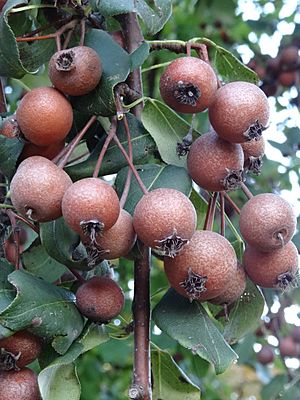Plymouth pear facts for kids
Quick facts for kids Plymouth pear |
|
|---|---|
 |
|
| Conservation status | |
| Scientific classification | |
| Genus: |
Pyrus
|
| Species: |
cordata
|
| Synonyms | |
|
List
|
|
The Pyrus cordata, also known as the Plymouth pear, is a special kind of wild pear tree. It is part of the Rosaceae family, which includes roses and apples. This tree got its name because it was first found near the city of Plymouth in Devon, England, back in 1870.
The Plymouth pear is a small tree. It often grows in hedgerows or at the edge of forests. It is one of the rarest trees in the United Kingdom. Because it is so rare, it is protected by law under the Wildlife and Countryside Act. Seeds from this tree are stored at Kew's Millennium Seed Bank to help save the species.
Contents
What Does the Plymouth Pear Look Like?
The Pyrus cordata is a deciduous shrub or a small tree. This means it loses its leaves in the autumn. It can grow up to 10 metres (about 33 feet) tall.
This tree is quite tough and can handle cold weather. However, for it to grow fruit and seeds, the weather needs to be just right. Its flowers bloom from April to May. The flowers are pale cream with a little pink. They have both male and female parts (called hermaphrodite). Insects help to pollinate them.
The flowers have a unique smell that some people find unpleasant. It is often compared to things like rotting seafood or wet carpets. This smell helps to attract flies, including some that are usually drawn to decaying plants.
Where Does the Plymouth Pear Grow?
The Plymouth pear is found in Western Europe, mainly near the Atlantic Ocean. You can find it in France, especially in Brittany. It also grows in Spain, particularly in Galicia, and in Portugal. In the United Kingdom, it is very rare. It is only found in Devon and Cornwall. Scientists think it might have been brought to the UK a long time ago.
Where Does the Plymouth Pear Live?
This tree likes to grow in thick bushes and open woodlands. It prefers places with cool, mild climates, usually in lowlands and hills. We do not know much about what it needs to grow well in the UK. So, people who work to protect nature are studying how it grows in Brittany to learn more.
Plymouth Pear in the UK
The Plymouth pear gets its English name from where it was first found. This was in Plymouth in 1871 by a local nature expert named T. R. Archer Briggs. In the UK, this tree is very rare. It is only found in two main areas: Plymouth and Truro.
The trees in the UK do not have much genetic diversity. This means the trees in Plymouth and Truro are almost identical. This suggests that one group of trees might have grown from parts (like cuttings) taken from the other group.
This lack of genetic diversity is a problem for the trees. It means that most of their seeds cannot grow into new trees. To help, scientists are trying to grow trees in special gardens. They are also trying to encourage small changes in the trees' genes. This might help them to breed more successfully. They are careful not to bring trees from Europe into the UK. This is because they want to keep the UK trees unique.
The two groups of Plymouth pear trees in the UK are also at risk from human activities. However, they are being protected in special areas. Botanists at Kew Gardens believe the Plymouth pear was brought to Britain from Brittany many hundreds of years ago. It was likely used as a plant for hedges.
Places You Can Find It
- Estover Industrial Estate, Plymouth.
- Cannon Mill industrial estate, Estover Road, Plymouth.
- Yardley Gardens at Estover.
- Derriford Hospital in Plymouth (opposite the entrance and in the car park).
- Truro: In hedges along country lanes just south of the city.
- Forder Valley Nature Reserve.
- Efford Marsh Nature Reserve.
- Plymbridge Lane, Plymouth.
Special Trees to See
- Royal Botanic Gardens: Three trees are located outside Queen's Cottage.
- Wakehurst Place: This is Kew's country garden.
- Charles Church roundabout in Plymouth.
- Carclew House, near Truro.
- Lanhydrock estate: The National Trust planted several trees here in 1996 to help them recover.
- Tregothnan House gardens, Cornwall.
See also
 In Spanish: Peral silvestre atlántico para niños
In Spanish: Peral silvestre atlántico para niños


